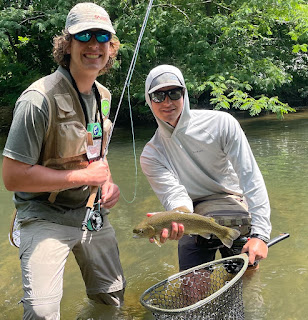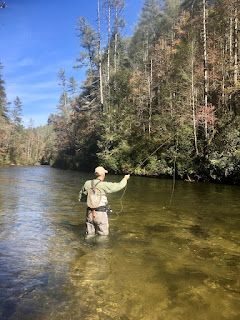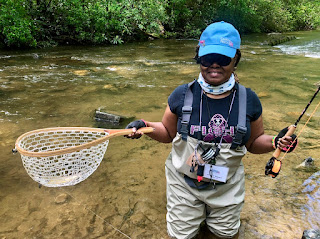Flyfishing appeals to many of us because we are always learning something new. Like golf, each day presents new challenges, and our success is not guaranteed - but very sweet when we achieve it. But flyfishing can be intimidating to new anglers. This column simplifies the sport. I boil it down to the basics for trout flyfishing this fall.
I recently gave this program to the UGA 5Rivers Fishing Club. Some of the intel in the presentation appealed to those young fly anglers, so I thought I’d write it up for all of our loyal UO followers.
I’ll outline this as the “Q&A’s of fall trouting” and cover the four main Q’s: 1) who, 2) where, 3) what, and 4) how, to be successful as our weather finally cools. I’ve collected a lot of our past online guidance and placed it into this article as “one-stop shopping” for our newer flyfishers.
First, who? The “who” is you! My advice is to buddy-up, as fishing is more enjoyable and safer with a good friend or two along for the trip. And if you’re rookies, please get adopted by an experienced angler or two. Your learning curves will be much flatter with regular doses of their gray-haired wisdom. YouTube is great, but an instream mentor or guide is the best teacher. Find some friends by hanging out at your local fly shop or joining a group like a 5Rivers college club, the GA Women Flyfishers, or a local TU chapter near you. Those clubs and chapters are listed here:
https://www.georgiawomenflyfishing.com/
https://georgiatu.org/find-your-georgia-tu-chapter-here/
Many of them have regular club fishing trips, so try one out. You may also find some friends via online trout fishing groups like North GA Trout Online or the GA Trout Anglers Facebook group. Mentors are worth their weight in gold!
Now the “where.” For rookies, it’s hard to beat Delayed Harvest ( DH) streams. They’re stocked regularly and managed under catch & release regulations. Most state agencies have good online maps of these waters. For GA, the Wildlife Resources Division has a trout page full of intel. Visit it here:
https://georgiawildlife.com/Fishing/Trout
If you scroll farther down the trout page to the special regulation section, you’ll notice the DH streams named. Click on each name and poof, you’ll discover a stream map! Here’s an example.
For starters, try Smith Creek in Unicoi State Park as a small stream option and the Chattooga River on the SC border for a taste of big waters.
Several NC DH waters, such as the Tuckaseegee, Nantahala, and Fires are also within striking distance. The Wildlife Resources Commission also has some great maps. Start your search here:
https://www.ncwildlife.org/fishing/fishing-in-north-carolina
Then go through the menus as follows: where to fish, public mountain trout waters, regulatory classifications- choose DH and hit the search button. From that stream list, pick one and click on its map icon on the left. Poof- you have an interactive trout map. Here’s an example, the Nan near Andrews:
If you’re more experienced and would like the challenges of wild trout this fall, hit the high elevation headwaters of trout watersheds in GA and NC. The Chattooga, Hooch, Little Tennessee, and Toccoa watersheds all have some good opportunities for bushwackers stalking small, cagy residents of cold tribs, up high. Dry/dropper techniques work well. Residents will attack your dries while water temps stay above 50. Below that mark, your subsurface dropper will get more attention and your dry will serve as the strike indicator.
The mountains of NC national forests are full of trout streams, as are the Smokies. Those taller mountains north of our border keep more waters cold through our hot summers. The national park also has a great interactive map here:
https://www.nps.gov/grsm/planyourvisit/maps.htm
For more info on stream opportunities, consider buying these guide books: 1) Peach State Trout by Jimmy Jacobs, the Flyfishers Guide to NC & GA by Nick Carter, and the FF Guide to GSMNP by Jim Casada.
https://shoponline.unicoioutfitters.com/fly-fishing-for-peach-state-trout-jimmy-jacobs.html
On to our third topic, the “what.” When rookies ask trouting vets what they caught all their trout on, many vets will reply, “a good drift.” In most cases, “how” trumps “what,” as our technique is more important than the fly pattern. So having a basic box of bugs is all you need to get started. Just pay very close attention to our upcoming topic, the “how.”
Long ago, I suggested a basic box of a dozen fly patterns. It’s still a good reference. You can find it here, on Rabun TU’s website.
Click on about Rabun TU, then education, then secrets. Near the bottom is the basic fly box. (Peruse the other topics, too, for some great intel.) Here’s the box:
For fall and winter fishing, just load up on six subsurface patterns: egg, worm, rubberleg stone, woolly bugger, hares ear nymph, and pheasant tail nymph. Buy at least three flies of each pattern because you’re going to lose some flies to fish, trees, and submerged boulders.
Before next spring, you can add those dry fly patterns to your box. Fished right, these 12 patterns will put you on fish year-round and across the country. You can add other “hot fly” patterns as your time and budget allow, but first stock up on these dozen bugs and learn how to fish them well.
Which brings us to the most important aspect, the “how.” If you can master the heron-stalk, the short cast, and the drag-free drift (DFD) you’ll be in business. An outline of the DFD is on that Rabunite secrets page, and a brief narrative and two great demo videos are in our blog, here:
http://blog.angler.management/2021/11/the-dfd-and-hooksets-are-free.html
If your strike indicator floats downstream at the same speed and in the same current line as an adjacent leaf or bubble, you’ll be in business. Just be sure that indi “ticks” occasionally to show you that your flies are bumping the bottom every now and then.
That’s all you need to know to have some early flyfishing success this fall. Grab a buddy, get adopted by a mentor, scope out a DH stream or two, and arm yourself with a well-stocked box of the 6 or 12 fly patterns. Most importantly, dress like a rhododendron bush, stalk like a blue heron, and perfect your drag-free drift. Before you know it, that flimsy fly rod will bend and dance, and you’ll be hooked for life.
Just like us. Welcome to the affliction. There is no cure. We all must simply take regular treatments!
There are costs for this great intel. Are you ready to pay? First, pass it on. When you enhance your own skills, watch for that struggling streamside newbie and be the hero. Take an hour out of your day to offer a hot fly and some instream advice. Turn their crummy day into a memorable one. You’ll catch some smiles that will rival those spawned from the fish you landed. Second, conserve. Do your part to protect trout waters and their forested watersheds. Join a conservation group and be the next generation of caretakers for your adopted waters. Do we have a deal?
Good luck from our UO gang. Tune in to our weekly fishing reports for more timely tips.
http://blog.angler.management/
Stop in or call us if we can help you further down your trail of flyfishing success!
Unicoi Outfitters: Friendly. Local. Experts.



























No comments:
Post a Comment